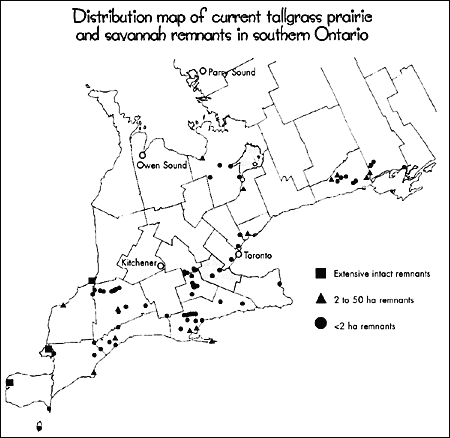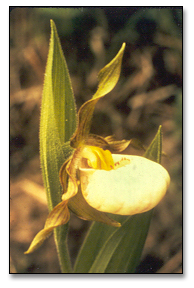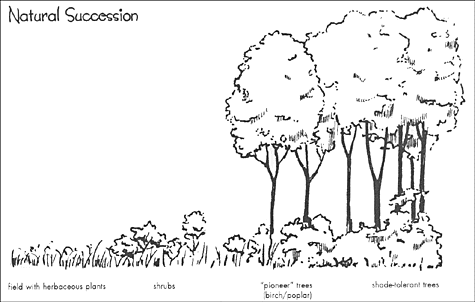Theme 9: Tallgrass Prairies
"The lands on the east side of the river are bordered by prairies in such a way
that the inhabitants have no wood to cut in order to clear their fields
and sow their grain. It is only necessary to plough the land and to cut
some shrubs."
(Lajeunesse 1960. Written by de Lery who visited the Windsor area in 1749).
Overview
Tallgrass prairies and savannahs are extremely rare ecosystems in Ontario.
They are also critically endangered ecosystems.
Many species that depend on these communities are at risk.
This theme describes Ontario's tallgrass prairie and savannah ecosystems,
their differences and characteristics, the flora and fauna that can be found
in tallgrass communities, and what is being done to restore many of these
biologically diverse ecosystems.
Educator's note:
An excellent supplement for this lesson is
"Grasslands", Family Nature Notes (Summer 1999).
This 4-page handout is available for $1 each.
Order them online at www.ontarionature.org
or by phone at (416) 444-8419.
|
Distribution of tallgrass prairie and savannah in Ontario
Southwestern Ontario may have once been covered by almost 2,000 square kilometres of
tallgrass prairie, stretching over large portions of
Essex, Kent, and Lambton counties, and smaller portions of
Elgin and Middlesex counties.
These tallgrass prairies also occurred around the Scarborough Bluffs and the
river bluffs along the Credit and Lower Rouge rivers, along the shores
of lakes Erie, Huron, Ontario, and Simcoe, and major rivers
such as the St. Clair, Thames, and Grand River.
|
Brant County was described by Colonel Edward Talbot in 1824:
...there are extensive tracts of land almost wholly free
from any sort of timber.
Such land is commonly called "Plains", and it is
for the most part of a light sandy nature, badly watered, and greatly inferior to the
timbered land ... From the Indian settlement on the River Ouse (near Brantford), to the
village of Burford, a distance of nearly 13 miles, there is not an acre of woodland to be seen,
and yet, in this tract alone, there are at least 100,000 acres...
|
 |
|
From: Rodger, L. 1998. Tallgrass Communities of Southern
Ontario: A Recovery Plan. WWF Canada. 7 pages.
|
The word "prairie" is French for "meadow".
Prairies are nearly treeless ecosystems, characterized by dominant grasses, sedges and
wildflowers.
There are three main types of prairies in North America: tallgrass, mixed grass, and shortgrass prairie.
Tallgrass prairies can still be found in southern Ontario, which part of
an area known as the "prairie peninsula" or "archipelago",
describing the tallgrass communities that occur across the northeastern United Sates
and into Ontario.
Savannahs, on the other hand, are areas of open-grown trees or shrubs
that grow out over a continuous ground cover of non-woody or herbaceous plants.
Oak savannahs are most closely associated with tallgrass prairie in southern Ontario,
identified by the open-grown oak trees over a ground cover of tallgrass prairie plants.
|
There are four types of savannah in the mid-western U.S. and Canada: aspen parkland;
pine barrens; cedar glade; and oak savannah.
|
 |
|
white lady slipper's orchid.
Photo: FON |
Tallgrass communities are made up of specially adapted species of grasses and wildflowers, some
as high as three to four metres, growing over flat or rolling land.
(If some of the tallgrass species were growing in a classroom, many would
literally bend over at the ceiling.)
These communities are rich and diverse habitats -- a two-hectare patch of tallgrass prairie,
for example, can support over 100 species of plants, that, in turn, support
a wide array of fauna, from leafhoppers to birds and mammals.
Plant species can include big bluestem, little bluestem, Indian grass, switch grass, cord grass,
spiked blazing star, grey-headed coneflower, sneezeweed, nodding wild onion,
and prairie dock with its half-metre-long leaves.
Early spring brings the endangered small white lady's slipper orchids,
arrow-leaved violet, wood betony, and wild lupine into bloom.
By mid-summer tall groups of butterfly milkweed, dense blazing star, and
tall sunflower move like waves in the wind.
Mammal and bird life in these communities includes
meadow voles, the tufted titmouse,
hawks, owls, and a variety of songbirds, squirrels, coyotes,
and deer.
Some of the less common mammals are the meadow jumping mouse and Baird's deermouse.
The endangered loggerhead shrike, whose population numbers have drastically declined, was
originally a grassland species.
The threatened eastern fox snake, Butler's garter snake (special concern/vulnerable)
and the eastern Massassauga rattlesnake (threatened in Ontario) can also be found
in tallgrass ecosystems.
Butterflies include the spicebush swallowtail and scrub-oak hairstreak.
What's happening to...
By the mid-1800s, most of the tallgrass prairies and oak savannahs in Ontario,
and for that matter, throughout North America, were converted to agriculture and urban
development.
It's easier to plough grassland than it is to log a forest and, since the land
was relatively flat and rolling and the soils were rich and thick, the
tallgrass prairies were among the first to go.
And with them the species that depended upon these ecosystems.
No longer does the eastern elk inhabit the once expansive southern
Ontario grasslands; it is extinct.
Butterflies that depend on tallgrass plants have all but disappeared, including the
Karner blue, an invertebrate designated
extirpated nationally, and endangered in Ontario.
Savannahs and tallgrass ecosystems are now considered some of the most endangered in North America.
In southern Ontario, less than three percent of the province's original tallgrass prairies
and savannahs remain.
Even those remnants are fragmented, isolated patches that are
simply too small to support species such as the endangered American badger and Henslow's sparrow.
Tallgrass plant species are naturally adapted to periodic fires.
Nutrients are recycled and successional species (flora and fauna changing over time and
sometimes replacing each other) are thus prevented from taking over.
Historically, it was common practice to suppress fires in
the grassland prairies and savannahs, but
today the ecology of these ecosystems is better understood, and fires are often
intentionally set to encourage regeneration of native plant species.
 |
|
It is one thing to convert tallgrass communities into what were once relatively simple agricultural uses.
Some tallgrass bird species successfully adapted to the conversion of their habitats from grassland
to pasture and hayfields.
But today the pressure to intensify agricultural practices and realize higher crop yields is
reducing even the biological diversity of
agricultural land.
Monoculture ("mono"=one; "culture"=plant) replaces
what may have once been mixed pastures of hay and oat fields,
which some grassland birds were able to adapt to.
Intensively cultivated, expansive fields of single crop species,
often sprayed with pesticides and herbicides, no longer offer the mix of
hedgerows, marshes, and meadows that provided habitat and food (e.g., insects) for some grassland species.
When it comes to diversity, the number of individual organisms
in an area is not as important as the number of different species in the area.
For example, there are thousands of corn plants in a farmer's field but that is only one type of plant.
Although there may be fewer plants in a woodlot or a tiny area of remaining tallgrass prairie,
there may be several different types of trees, shrubs, grasses and wildflowers.
It is the degree of species variety that gives an area its diversity.
|
Grasses grow from the bottom of the stem, underground, whereas most other plants
grow from the tip of the plant, above ground.
This is why tallgrass prairie species can withstand grazing and fire much better
than most plants.
The part of the plant responsible for its growth is not damaged by either.
|
What's happening for...
Fortunately, a few patches of grassland habitats remain, fragmented and isolated
though they may be.
In the Canadian prairies, efforts are being made to conserve and preserve some of the last
remaining grassland communities.
In the United States, grassland guidelines recommend conserving grassland areas
of 50 to 100 hectares, and protecting smaller patches if the larger ones do not exist.
This process is more complex than it would seem as many different jurisdictions
as well as private landowners, are often involved.
In Ontario, monitoring efforts -- the Ontario Rare Breeding Bird
Program (ORBBP) and the Breeding Bird Survey (BBS) to name but two --
and recovery teams for tallgrass bird species are producing conservation guidelines
that will benefit many species.
In 1998, MNR and WWF Canada developed an extensive recovery plan, laying out the
status of tallgrass prairies and savannahs in Ontario.
The goal of the plan is to recover, reconstruct, and conserve a representative network of tallgrass communities
and the full range of species vital to the biological diversity of these ecosystems.
Protected tallgrass communities in Ontario include the finest remaining example of tallgrass prairie
on Walpole Island, in Lake St. Clair.
About one-sixth of the landmass located at the north end of the Bird's Foot delta complex
at the mouth of the St. Clair River is covered
by forest, savannah, and prairie communities -- other portions are given over to agriculture
wetlands, and marshes.
The oak savannah, tallgrass prairie, and flora and fauna here
are of international significance.
Unfortunately, Walpole Island's tallgrass communities
are still in jeopardy -- chemicals still spill into the
St. Clair River, emissions from nearby garbage incinerators still spew out
(all of which affect the integrity of the water and air), and about
4,000 hectares of the reserve have been converted for agricultural purposes.
Finally, some savannah and prairie communities have been destroyed
to make way for housing.
In the City of Windsor, in what is called the Ojibway Prairie Complex,
approximately 425 hectares of oak forest, savannah, and prairie grasslands are
protected through a combination of designations:
nature reserve (regulated under the Provincial Parks Act), parkland (administered by the city),
public land (owned by either the Crown or the City of Windsor),
and private ownership.
Of that total, the Ojibway Park, Black Oak Woods Heritage Park, Tallgrass Prairie
Heritage Park (127 hectares), and Ojibway Prairie Provincial Nature Reserve
(approximately 65 hectares) together host well over 600 plant species,
over one-sixth of which are considered rare.
Educator's note:
For greater detail on Walpole Island, see our "Grasslands"
Nature Notes, available
online
or by phone at 416 444-8419.
|
Ecosystem Diversity
A diverse ecosystem includes many different species of plants and animals.
Have students list and compare the number of species found in a tallgrass
prairie ecosystem, a forest, and a cornfield. Which ecosystem is the
least diverse?
How might this affect species living in the area?
Species include: big bluestem, little bluestem, Indian grass, switch grass, cord grass,
spiked blazing star, grey-headed cone flower, sneezeweed, nodding onion, prairie dock,
butterfly milkweed, tall sunflower, songbirds, small rodents, raptors,
snakes, large carnivores, deer, and a wide variety of insects.
Species include: varieties of trees, shrubs, grasses, mosses, lichen, fungi,
birds, mammals, reptiles, amphibians, invertebrates.
Species include: corn, possibly a few other plant species, some birds
(red-winged blackbirds, small songbirds), some insects (likely very few due to spraying
of pesticides), some soil organisms.
Tallgrass prairies and forests are examples of diverse ecosystems, whereas agricultural crops or lawns
are examples of monocultures.
What you can do!
Could you identify a grassland species at risk?
A Henslow's sparrow or a loggerhead shrike?
The small white lady's slipper?
A Karner blue butterfly?
Plant a prairie in your schoolyard!
Plants such as little bluestem, butterfly weed, sunflower,
and wild lupines attract butterflies and birds, are very attractive and, best of
all, low maintenance and hardy!
Are you part of a farming family or agricultural community?
If so, you may be interested to know that the future of tallgrass species
in Ontario will depend to a large extent on changing agricultural practices.
In 1993, a coalition of farm groups developed a program called the
Ontario Environmental Farm Plan.
Simply, farmers who implement environmentally friendly farming practices are eligible
for grants of up to $1,500 as an incentive to rate their
practices against the needs of habitats such as wetlands, floodplains, and woodlands.
Grassland species, too, would benefit if farming practices left grassy verges
and treed corridors or buffer areas alone
(see also Ontario Soil and Crop Improvement Association).
As another option, the
Ecological Farmers Association of Ontario
educates farmers on ecological methods of farming that maintain and enhance the health of the soil,
the crops, the livestock and the farm community through the understanding
of ecological principles.
Help raise awareness about grassland habitats and species.
Locate remaining tallgrass habitats on a more detailed map of your own area.
Visit it if you can, on your own or as a class or a group, and note what it looks like.
-
Are there any trees? If so, what are they like?
-
What types of trees are they? Are there many or few?
-
How many different plants can you identify?
-
Is it raining or sunny?
-
What do you hear? What do you smell?
-
Does the air feel dry or moist?
-
Is there anything moving around out there?
-
What else do you see, hear, smell, and feel?
Create a poster or display for Environment Week, and/or
write letters to the newspapers in your community telling people
the importance of protecting what's left of tallgrass and savannah communities
in Ontario.
|
|
|
|